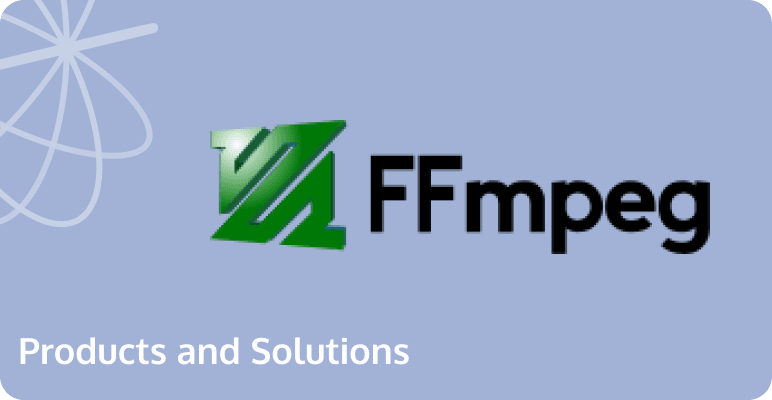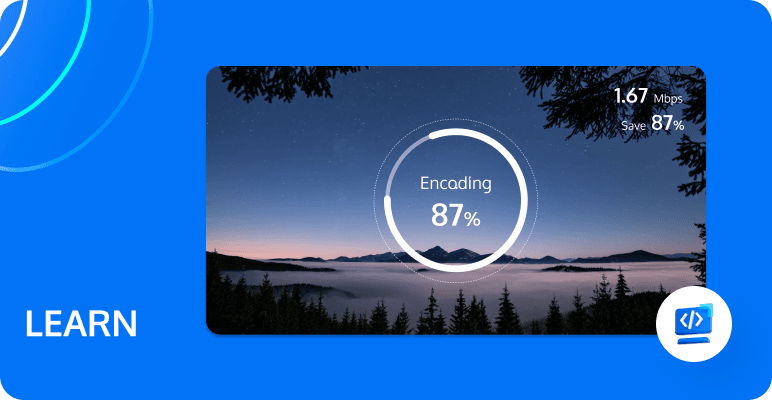Multi-Format Codec: Compatible, efficient, flexible, integrated
What is a Multi-Format Codec?
Multi-Format Codec is a software or hardware solution that supports encoding and decoding of multiple audio and video formats. It enables cross-format media processing and playback, providing compatibility, efficiency, and flexibility in multimedia applications.

The development process of Multi-Format Codec
A review of the development history
The development history of Multi-Format Codec is closely related to the development history of digital audio and video technology. Here are some key historical stages:
- Early codecs: In the early days of digital audio and video technology, audio and video codecs were usually single-format, such as early MPEG-1 and MPEG-2 video codecs, as well as MP3 and AAC audio codecs.
- Emergence of multi-format codecs: With the development of digital audio and video technology, codecs supporting multiple formats emerged. These codecs can process various audio and video formats, providing greater flexibility. For example, FFmpeg is an open-source multi-format codec library that supports numerous audio and video codecs.
- Hardware-accelerated multi-format codecs: To improve audio and video processing efficiency, some hardware manufacturers began to integrate multi-format codecs into hardware, such as Intel's Quick Sync Video and NVIDIA's NVDEC/NVENC. These hardware-accelerated codecs can significantly improve the speed and efficiency of audio and video processing.
- Open-source and standardized multi-format codecs: With the advancement of the open-source and standardization movement, some open-source and standard multi-format codecs emerged, such as VP9 and AV1. The emergence of these codecs has promoted the development of multi-format codecs, making audio and video processing more open and standardized.
These are some key stages in the development history of multi-format codecs, reflecting the development trends and challenges of digital audio and video technology.
Current Development Status
Currently, Multi-Format Codec plays a crucial role in the audio and video industry, and its development status is mainly reflected in the following aspects:
- Diversified codec formats: With the continuous development of digital audio and video technology, more and more audio and video codec formats have emerged, such as H.264, H.265, VP9, AV1, etc. Multi-format codecs need to be constantly updated and expanded to support these emerging formats.
- Popularization of hardware acceleration: To improve the efficiency of audio and video processing, hardware-accelerated multi-format codecs are becoming more and more popular. Many processors and graphics cards have integrated multi-format codecs, such as Intel Quick Sync Video, NVIDIA NVDEC/NVENC, and Apple VideoToolbox.
- Open-source and standardization: The open-source and standardization movement has made significant progress in the field of multi-format codecs. Many open-source codec libraries (such as FFmpeg and GStreamer) and open-source codec formats (such as VP9 and AV1) have been widely used and supported.
- Cross-platform compatibility: With the popularity of mobile devices and cloud computing, multi-format codecs need to provide good compatibility on various platforms. Many codec libraries and frameworks already support cross-platform development, such as FFmpeg, GStreamer, MediaCodec (Android platform), and VideoToolbox (iOS/macOS platform).
- Real-time and low-latency applications: With the popularity of real-time video communication and gaming, multi-format codecs need to meet the demands of real-time and low-latency. To this end, many codecs consider real-time performance in their design, such as H.264's low-latency mode.
- High resolution and high quality: The popularization of 4K and 8K high-resolution videos requires multi-format codecs to have higher compression performance and quality. To this end, emerging codec formats such as H.265 and AV1 have made significant progress in compression performance and quality.
In summary, the current development status of multi-format codecs in the audio and video industry presents characteristics of diversification, hardware acceleration, open-source, cross-platform, real-time, and high quality. With the continuous development of technology, multi-format codecs will continue to adapt to new challenges and demands.
Principle of Multi-Format Codec
The implementation principle of Multi-Format Codec involves audio and video encoding and decoding technology. Conceptually, a multi-format codec is actually the integration of multiple independent codecs into a framework or library to support various audio and video formats. The following are the general implementation principles of multi-format codecs:
- Codec registration and management: Multi-format codecs need to implement a set of registration and management mechanisms to dynamically load and unload different codecs during runtime. This usually involves codec initialization, resource allocation, and release operations.
- Data demuxing and muxing: Multi-format codecs need to handle various audio and video container formats, such as MP4, MKV, and WebM. This involves demuxing input data, extracting audio and video streams, and then muxing decoded data to generate output files.
- Codec scheduling and adaptation: Multi-format codecs need to automatically select the appropriate codec for processing based on the input data format and user requirements. This usually involves balancing factors such as codec priority, performance, and compatibility.
- Codec implementation: Multi-format codecs usually include multiple independent codec implementations, such as H.264, H.265, VP9, AV1, etc. These codecs implement their respective format encoding and decoding algorithms, such as predictive coding, transform coding, entropy coding, etc.
- Hardware acceleration support: To improve audio and video processing efficiency, multi-format codecs may need to support hardware acceleration technologies, such as Intel Quick Sync Video, NVIDIA NVDEC/NVENC, and Apple VideoToolbox. This involves adapting to the interfaces and protocols of hardware accelerators.
- API and framework: Multi-format codecs usually provide a unified API and framework for easy use by users and applications. This involves the design and implementation of codec configuration, control, error handling, and other functions.
In summary, the implementation principle of multi-format codecs involves aspects such as codec registration and management, data demuxing and muxing, codec scheduling and adaptation, codec implementation, hardware acceleration support, and API and framework. By integrating these technologies into a framework or library, multi-format codecs can support the processing and playback of various audio and video formats.
Advantages and Disadvantages of Multi-Format Codec
Advantages:
- Compatibility: Multi-format codecs can handle various audio and video formats, ensuring compatibility across different devices and platforms.
- Efficiency: Multi-format codecs can achieve high-quality encoding and decoding with lower computational resource consumption.
- Ease of use: Multi-format codecs usually have a simple user interface and easy-to-use operation methods.
- Scalability: Multi-format codecs can add new encoding and decoding algorithms as needed to adapt to the constantly evolving audio and video technology.
Disadvantages:
- Complexity: Due to the need to support multiple formats, the implementation of multi-format codecs is relatively complex. This may result in higher development costs and maintenance difficulties.
- Performance overhead: Multi-format codecs need to detect and select the appropriate codec during runtime. This may cause additional performance overhead, especially on resource-constrained devices.
- Latency: Due to the need to process multiple formats, multi-format codecs may introduce more latency. This may be an issue for real-time communication and low-latency applications.
- Integration challenges: Integrating multiple codecs into a single system may pose challenges. This may require more memory and processor resources, as well as better resource management strategies.
- Copyright and licensing issues: Different codecs may involve different copyrights and licensing agreements. Using multi-format codecs may mean dealing with multiple licenses, which may increase legal risks and business costs.
- Quality differences: Due to the support of numerous formats, multi-format codecs may not perform as well in terms of quality and performance for certain specific formats as codecs optimized specifically for that format.
- Updates and maintenance: With the emergence of new codecs and formats, multi-format codecs need to be constantly updated and maintained to maintain their compatibility. This may bring additional costs and workload.
To overcome these disadvantages and bottlenecks, the following strategies can be adopted:
- Optimize algorithms and architectures to reduce performance overhead and latency.
- Use efficient resource management strategies to reduce memory and processor resource occupation.
- Choose high-quality codecs to improve compatibility and performance.
- Follow open standards and open-source licenses to simplify licensing and legal issues.
Common Multi-Format Codecs and Comparisons
| Multi-Format Codecs | Advantages | Disadvantages |
| FFmpeg | Open-source, supports numerous audio and video codecs, cross-platform, powerful features, widely used in audio and video processing, transcoding, and streaming media fields. | For beginners, there may be a learning curve. |
| GStreamer | Open-source, supports multiple audio and video codecs, cross-platform, plugin-based architecture, easy to expand, widely used in media players and streaming media servers. | Compared to FFmpeg, it has a lower market share. |
| VLC Media Player | Open-source, built-in multiple audio and video codecs, supports various file formats, cross-platform, easy to use. | Mainly used for playback and simple transcoding tasks, not suitable for complex audio and video processing and development. |
| MediaCodec (Android platform) | Official support, supports various audio and video codecs, compatible with Android device hardware acceleration, suitable for Android application development. | Only applicable to the Android platform. |
| VideoToolbox (iOS/macOS platform) | Official support, supports various audio and video codecs, compatible with Apple device hardware acceleration, suitable for iOS and macOS application development. | Only applicable to iOS and macOS platforms. |
| Intel Quick Sync Video | Hardware acceleration, supports various audio and video codecs, compatible with Intel processors, improves audio and video processing and playback efficiency. | Only applicable to devices with Intel processors. |
| NVIDIA NVDEC/NVENC | Hardware acceleration, supports various audio and video codecs, compatible with NVIDIA graphics cards, improves audio and video processing and playback efficiency. | Only applicable to devices with NVIDIA graphics cards. |
In general, these multi-format codecs differ in functionality, platform compatibility, and hardware acceleration. When choosing a multi-format codec, you need to weigh the actual needs and application scenarios.
Future Development Trends of Multi-Format Codec

With the continuous development of digital media technology, the future trends of Multi-Format Codec mainly reflect the following aspects:
- More efficient encoding and decoding algorithms: With the popularization of high-resolution videos such as 4K, 8K, and VR, future multi-format codecs need to support more efficient encoding and decoding algorithms to achieve higher compression performance and better video quality. For example, emerging H.266/VVC, EVC, and LCEVC encoding and decoding standards have already explored this area.
- Stronger hardware acceleration: To improve audio and video processing efficiency, future multi-format codecs need to support stronger hardware acceleration. This not only includes traditional CPU and GPU acceleration but may also include emerging AI chips and FPGA hardware acceleration.
- Wider open-source and standardization: The open-source and standardization movement will continue to promote the development of multi-format codecs. By being open-source and standardized, it can lower technical barriers, promote technological innovation, and improve market competitiveness.
- Deeper AI integration: Artificial intelligence (AI) technology is gradually being applied to the field of audio and video encoding and decoding. Through AI technology, more intelligent encoding decisions, more efficient compression, and better video quality can be achieved. For example, AV1 has begun to explore content-adaptive encoding using AI.
- Stronger real-time and low-latency: With the development of 5G and edge computing, applications such as real-time video communication and cloud gaming have increasingly higher demands for real-time and low-latency. Future multi-format codecs need to meet the demands of these applications, providing stronger real-time and low-latency capabilities.
In summary, the future trends and development prospects of multi-format codecs are very broad. With the continuous advancement of technology, multi-format codecs will continue to play an important role in the field of audio and video processing and playback.

